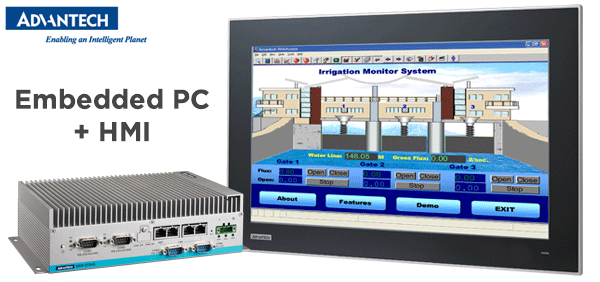With the increase in demand for diversified HMI (Human Machine Interface) PCs, I thought that it was important to address the three reasons why pairing an Embedded PC with your HMI is the right move to make.
1. Everything Wrapped in One
Application software can be demanding on the integrated hardware driving it, which is one great reason to pair an Advantech Embedded PC with an Advantech Flat Panel Monitor. It’s not always easy to meet all of the demands by using a stand-alone Touch Panel Computer, Panel PC or Industrial Panel PC.
This is where you can combine two entities configured to your application specifications that will provide the ultimate solution.
The user is able to select an Advantech Embedded PC with the appropriate CPU, RAM, Storage and Power Input (24V DC or 120V AC), while also selecting a Flat Panel Monitor that has the cut-out dimensions, size of screen, touch type, interface and resolution that is required. You are also able to mount the Embedded PC on the Flat Panel Monitor, which is convenience for those applications where space is limited.
2. Decrease Down Time
If the hardware will be susceptible to rough usage and there’s the chance that spares will be required for out of warranty replacement when the displays are broken, an Embedded PC/Flat Panel Monitor combination is even more valuable.
Instead of having to swap out the entire PC, you are able to swap out just the screen. This not only cost-effective due to the price point of hardware but also due to the minimized downtime experienced by going this route.
It’s vital that all line, testers, machines, etc. are running 24/7, so this enables you to stay on track.
3. I/O Flexibility
Most HMI PCs do provide I/O access via the back or bottom of the display. In order to fit the screen, touch sensor and LCD into a compact bezel, the I/O has limitations. There’s only so much room, so usually there’s a LAN port, COM port or two and one or two USB ports. That may be just fine for some users but won’t address the I/O intensive applications where multiple LAN, COM and USB ports are needed. It also doesn’t address I/O expansion via PCI/PCIe slots, which is virtually non-existent on most HMI PCs with the exception being the Industrial Panel PCs. The Embedded PCs available can provide up to 4 LAN ports, 6 COM ports, 8 USB ports, HD resolution and three display ports.
That will wrap up things for today. I do hope that the information provided has been helpful to you.
As always, if you have any questions about what Embedded PC or Flat Panel Monitor would work best with your application, please contact our team!
